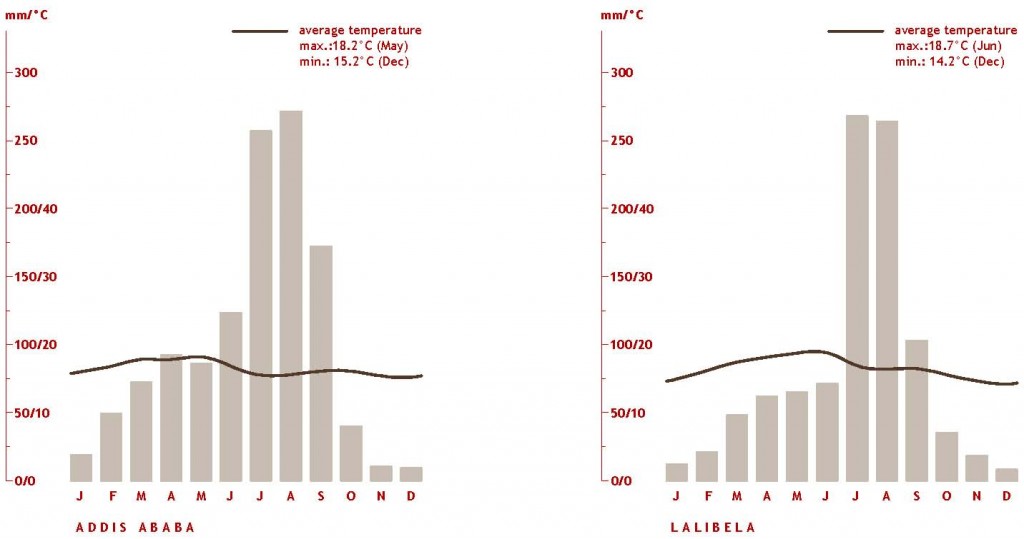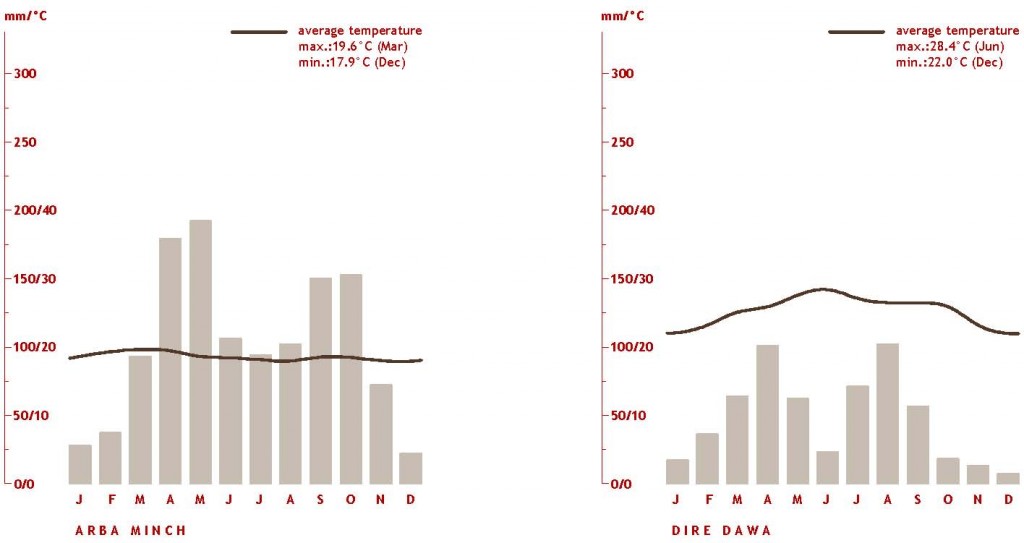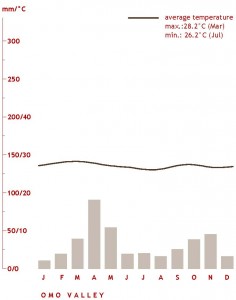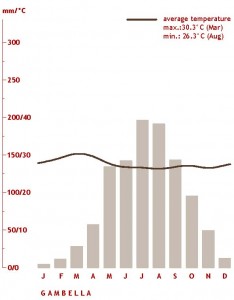Due to the varied topography of the country, Ethiopia has a large range of different climates ranging from the extreme heat of the Danakil Depression – the hottest point on the continent – to the cool mountain climate of the Bale and Simien Mountains. Roughly speaking, the country is split into two main climatic zones: the dry, warm valley of the Great African Rift Valley with an average temperature of about 22-25°C and the cooler highlands with an average temperature of around 16-18°C.
.
THE HIGHLANDS/ Addis Ababa, Gonder, Lalibela, Axum, Mekele, Harar
Prime Travel Dates * For the most beautiful scenery, it is recommended to travel just after the rainy season from late September to October/November. The best season overall is from October to mid-March. In April and May it can get rainy.
Temperature * Overall, the climate here is moderate with no extreme heat or cold. During the day, with clear skies and sunshine, the temperature is warm to hot, similar to a midsummer day in Western and Central Europe. However, due to it’s proximity to the equator and the altitude, the sunlight is much more intense. As soon as the sun sets, the temperature drops significantly bringing on much cooler temperatures. During the rainy season (June – mid-September) both the daytime and night time temperature is significantly lower and at night it can get quite cold. Following the rainy season (mid-September – December) the evening and night time temperature decreases even further, but during the day it becomes pleasant and warm once again, with the sunshine. The hottest months are usually April and May, just before the onset of the rainy season. During this time also in Addis Ababa mild evenings are possible. As a general principle, the temperature gets progressively cooler the higher the altitude.
The Rainy Season * In general, there are two rainy seasons per year. A shorter rainy season takes place from the end of March to the beginning of May. However, the rainfall during this period is not as frequent or severe as in the main rainy season. When it’s not raining, the sun shines and the land is warm. The main rainy season usually begins in early-June and ends mid-September. During this period it usually rains heavily at least once per day. The sky is often overcast, with the sun making infrequent appearances through the clouds. In the Bale Mountains, the rainy season begins and ends later in the year, usually from around August to late-October.
.
.
.
THE LOWLANDS / Awassa, Arba Minch, Nazreth, Awash, Dire Dawa
Prime Travel Dates * Since there is significantly less rain, it is possible to travel here all year round without any restrictions. The hottest temperatures are usually reached in the months of April and May.
Temperature * This region experiences high temperatures all year round. The summer nights are mild and the temperature is warm.
Rainy Season * In the regions to the North, the rainy season takes place around the same times as in the highlands, however with significantly less rainfall. In the regions to the South, the rainy season begins earlier in the year with heavy rainfall happening already around April and May.
.
.
.
OMO VALLEY / Turmi, Jinka, Konso, Key Afar
Prime Travel Dates * The best time to travel here is during the dry season (usually July to February) particularly because this is the period when some of the most traditional celebration and ceremonies take place. The impressive stick fights usually take place in August.
Rainy Season * Most precipitation falls from March to May and after heavy rains some areas are inaccessible due to the poorer road conditions.
.
.
.
THE WESTERN LOWLANDS / Gambella
This region experiences a tropical, hot and humid climate with heaviest rainfall from May to September. The hottest period is from February to April.
.
.
.
DANAKIL DEPRESSION / Dallol, Ertale, Hamed Ela
Prime Travel Dates * The best time to visit is from November to March. During the other months, this region is avoided due to the very high temperatures.
.
.
SPECIAL CELEBRATIONS / Christian Orthodox
Genna / Ethiopian Christmas / January 7th * Lalibela is the centre of the Ethiopian Christmas celebrations, where many faithful pilgrims visit for the occasion. During Genna a game is also played, similar to field hockey, between teams in rural areas.
Timket / Celebration of the Baptism of Christ / January 19th * During this celebration, large processions are held in which the Tabot of every church (The copy of the Ark of the Covenant) is carried festively through the streets. On the eve of the ceremony, the celebrations are held on a river or pool of water after which the Tabot is brought via a procession back to the church. The most colourful and ceremonious Timkat celebrations are held in Gonder.
Enqtatash / Ethiopian New Year / September 11th * To celebrate this day, most families slaughter a sheep or rooster.
Meskel / September 27th * On this day, Ethiopians celebrate the discovery of the true cross of Christ. Long wooden beams are formed into a crucifix and the highlight of the ceremony is reached when the wood is burnt creating a blazing bonfire into the sky. The yellow Meskel flowers, which only bloom at this time of year and only in Ethiopia, adorn the people, houses and streets.
.
.




